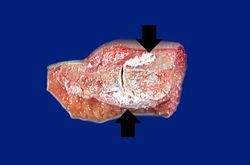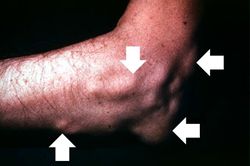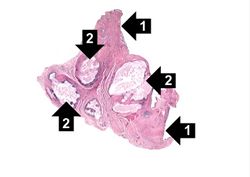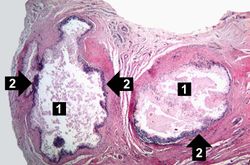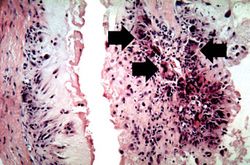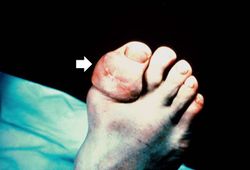From Pathology Education Instructional Resource
Revision as of 15:21, 20 August 2013
This is a gross photograph of an index finger from a patient with gout. The finger has been sectioned longitudinally to demonstrate the distal interphalangeal joint. Note the white chalky material within and adjacent to the joint (arrows).
This is a gross photograph of the elbow of this patient. The subcutaneous nodules (arrows) on this arm are tophi caused by gout.
This is a low-power photomicrograph of the tophus removed from the elbow of this patient. Note the fibrous connective tissue (1) and the large foci containing the urate crystals (2) surrounded by the intense chronic inflammatory reaction.
This higher-power photomicrograph of the tophus demonstrates the collections of urate crystals (1) and the inflammatory cells at the edge of these foci (2).
This is a higher-power photomicrograph of the edge of the tophus. Most of the urate crystals dissolve away during processing. The inflammatory cells at the edge of these foci are clearly visible (arrow).
This is a high-power photomicrograph of the edge of the tophus. The character of the intense chronic inflammatory cell reaction is evident and note the presence of giant cells within this inflammatory cell reaction (arrows).
This is a photomicrograph of a tophus that was fixed in alcohol prior to histologic processing. The alcohol fixation preserves the water soluble urate crystals within the tissue. Note the urate crystals visible in this photomicrograph (arrows). Also note the chronic inflammatory reaction in the background.
This is a gross photograph of a tophus on the great toe of another patient with gout (arrow). The healed surgical incision and the size of this tophus indicate that this was a long-standing problem for this patient.
